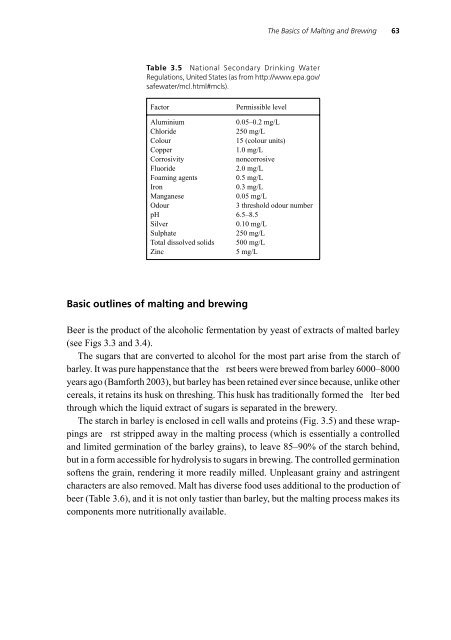Beer : Health and Nutrition
Beer : Health and Nutrition
Beer : Health and Nutrition
You also want an ePaper? Increase the reach of your titles
YUMPU automatically turns print PDFs into web optimized ePapers that Google loves.
Table 3.5 National Secondary Drinking Water<br />
Regulations, United States (as from http://www.epa.gov/<br />
safewater/mcl.html#mcls).<br />
Factor Permissible level<br />
Aluminium 0.05–0.2 mg/L<br />
Chloride 250 mg/L<br />
Colour 15 (colour units)<br />
Copper 1.0 mg/L<br />
Corrosivity noncorrosive<br />
Fluoride 2.0 mg/L<br />
Foaming agents 0.5 mg/L<br />
Iron 0.3 mg/L<br />
Manganese 0.05 mg/L<br />
Odour 3 threshold odour number<br />
pH 6.5–8.5<br />
Silver 0.10 mg/L<br />
Sulphate 250 mg/L<br />
Total dissolved solids 500 mg/L<br />
Zinc 5 mg/L<br />
Basic outlines of malting <strong>and</strong> brewing<br />
The Basics of Malting <strong>and</strong> Brewing 63<br />
<strong>Beer</strong> is the product of the alcoholic fermentation by yeast of extracts of malted barley<br />
(see Figs 3.3 <strong>and</strong> 3.4).<br />
The sugars that are converted to alcohol for the most part arise from the starch of<br />
barley. It was pure happenstance that the rst beers were brewed from barley 6000–8000<br />
years ago (Bamforth 2003), but barley has been retained ever since because, unlike other<br />
cereals, it retains its husk on threshing. This husk has traditionally formed the lter bed<br />
through which the liquid extract of sugars is separated in the brewery.<br />
The starch in barley is enclosed in cell walls <strong>and</strong> proteins (Fig. 3.5) <strong>and</strong> these wrappings<br />
are rst stripped away in the malting process (which is essentially a controlled<br />
<strong>and</strong> limited germination of the barley grains), to leave 85–90% of the starch behind,<br />
but in a form accessible for hydrolysis to sugars in brewing. The controlled germination<br />
softens the grain, rendering it more readily milled. Unpleasant grainy <strong>and</strong> astringent<br />
characters are also removed. Malt has diverse food uses additional to the production of<br />
beer (Table 3.6), <strong>and</strong> it is not only tastier than barley, but the malting process makes its<br />
components more nutritionally available.

















